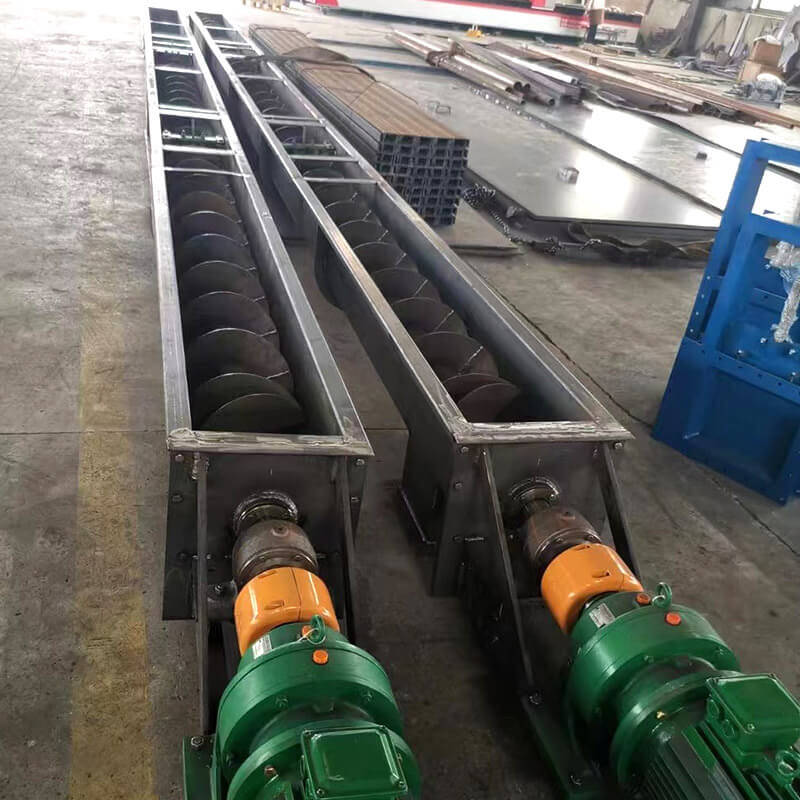O que é um transportador de parafuso?
A transportador de parafuso (também designado por transportador helicoidal) é um sistema mecânico utilizado para movimentar materiais a granel de forma eficiente. O Transportador de parafuso LS é um modelo industrial popular concebido para o transporte horizontal ou ligeiramente inclinado. Ao contrário de um correia transportadoraque utiliza uma correia móvel, um transportador de parafuso baseia-se numa lâmina helicoidal rotativa (parafuso) para empurrar os materiais para a frente.
Principais diferenças entre o transportador de parafuso e o transportador de correia:
Transportador de parafuso:
Totalmente fechado, evitando poeira e contaminação
Melhor para pós, grânulos e pequenos grumos
Suporta inclinações mais acentuadas (até 45° com design especial)
Menor manutenção, mas maior consumo de energia
Transportador de correia:
Aberto ou fechado, melhor para materiais grandes e pesados
Maior capacidade de transporte a longa distância
Menor degradação do material (sem efeito de esmagamento do parafuso)
Requer mais espaço e ajustes frequentes da correia
O que é uma Rosca Transportadora LS? Funções principais e princípio de funcionamento
O transportador de parafuso LS (também chamado de alimentador de parafuso) é uma máquina industrial amplamente utilizada para o transporte de materiais em pó, granulados e pequenos pedaços. "LS" significa "Screw" (parafuso) e "Level" (nível) de transporte. Sendo um equipamento essencial nas linhas de produção modernas, funciona através da rotação de lâminas em espiral para empurrar os materiais através de um tubo, permitindo um transporte eficiente e contínuo.
Especificações detalhadas:
Gama de diâmetros: 100mm a 1250mm (os modelos padrão incluem 100, 160, 200, 250, 315, 400, 500, 630, 800, 1000 e 1250mm)
Unidade única Comprimento: Até 35m (máx. 30m para os modelos LS1000 e LS1250)
Temperatura de funcionamento: -20°C a 50°C ambiente, manuseia materiais ≤200°C
Ângulo de inclinação: Melhor abaixo de 20°, modelos especiais até 45°
7 Vantagens Principais: Por que escolher uma Rosca Transportadora LS?
Design compacto: Poupa espaço, ideal para layouts de fábrica apertados
Vários pontos de carga/descarga: Permite a transferência de material em várias posições (termo profissional: portas intermédias de alimentação/descarga)
Transporte totalmente fechado: Evita a fuga de pó, cumpre as normas ambientais (palavra-chave: transportador helicoidal à prova de pó)
Baixos custos de manutenção: Mais simples e mais barato do que os transportadores de correia
Opções de materiais: Aço carbono, aço inoxidável (304/316), opções de qualidade alimentar e resistentes à corrosão
Caraterísticas personalizáveis: Motores à prova de explosão, variadores de velocidade, módulos de pesagem
Instalação flexível: Configurações horizontais, inclinadas ou verticais
Aplicações industriais: Que materiais funcionam melhor?
Materiais ideais:
Pós: Cimento, farinha, pó de carvão, talco
Grânulos: Grãos, granulados de plástico, fertilizantes
Pequenos pedaços: Carvão triturado, pequenas pedras, pellets de biomassa
Não recomendado para:
Materiais perecíveis (por exemplo, alguns ingredientes alimentares)
Substâncias de elevada viscosidade (por exemplo, asfalto, xarope)
Materiais que se aglomeram (por exemplo, certos produtos químicos)
Grumos grandes (diâmetro > 1/4 do tamanho do parafuso)
Guia de compra: 5 factores críticos de decisão
Análise do material: Densidade, humidade, fluidez, abrasividade
Cálculo da capacidade: Selecione o modelo com base nas toneladas/hora necessárias
Distância de transporte: Unidade única com um máximo de 35 m, ligue várias unidades para percursos mais longos
Condições especiais: À prova de explosão, à prova de água, necessidades de alta temperatura
Saldo orçamental: Compare o custo inicial com as despesas de funcionamento a longo prazo
Regras de instalação: 10 passos para um melhor desempenho
Prepare a fundação: Complete a base de betão com 20 dias de antecedência
Verifique as peças: Verifique se todos os componentes estão presentes e limpos
Alinhe as linhas centrais: Assegure um posicionamento horizontal/vertical correto
Ligações suaves: Mantenha as superfícies das juntas com uma diferença de altura de 1 mm
Fixe a base: Aperte com parafusos de alta resistência
Calibre os rolamentos: Apoie corretamente os rolamentos do suspensor intermédio
Aperte todos os parafusos: Aplique as especificações de binário corretas
Lubrifique os sistemas: Verifique os níveis de óleo na caixa de velocidades e nos rolamentos
Teste em vazio: Funcionamento sem material durante mais de 4 horas
Controlo de segurança: Instale paragens de emergência e coberturas de proteção

Operação e manutenção: Dicas de especialistas para prolongar a vida útil
Funcionamento diário:
Sequência de arranque: Ligue em vazio, depois alimente o material gradualmente (palavra-chave: procedimentos de funcionamento do transportador de parafuso)
Processo de paragem: Limpe todo o material antes de parar
Controlo da alimentação: Utilize um alimentador vibratório para uma entrada constante
Proteção contra objectos estranhos: Adicione telas na entrada
Calendário de manutenção:
| Nível | Tempo de execução | Duração | Tarefas principais |
|---|---|---|---|
| Diário | Por turno | 10 min | Limpar, apertar, verificar o lubrificante |
| Nível 1 | 720 horas | 4 horas | Inspeção completa, substitua as peças desgastadas |
| Nível 2 | 2400 horas | 16 horas | Revisão do sistema, substituição de rolamentos |
Resolução de problemas:
Ruídos estranhos: Verifique se há desgaste nos rolamentos ou objectos encravados
Capacidade reduzida: Inspeccione o desgaste da lâmina ou a potência do motor
Fugas de material: Examine a deterioração da vedação
Estudo de caso: Implementação da Fábrica Darko
Dois transportadores helicoidais LS400 funcionaram de forma fiável durante 3 anos na Fábrica Darko, conseguindo:
Transporte contínuo de cimento a 60 toneladas/hora
Controlo de poeiras em conformidade com a norma ISO 14644-1 Classe 7
25% menor consumo de energia do que os sistemas tradicionais
Comparação técnica: LS vs Outros Transportadores
| Caraterística | Transportador helicoidal | Transportador de correia | Elevador de balde |
|---|---|---|---|
| Vedação | ★★★★★ | ★★☆☆☆ | ★★★★☆ |
| Espaço necessário | ★★★★☆ | ★★☆☆☆ | ★☆☆☆☆ |
| Manutenção | ★★☆☆☆ | ★★★☆☆ | ★★★★☆ |
| Custo | ★★★☆☆ | ★★☆☆☆ | ★★★★☆ |
| Ângulo máximo | <20° | <30° | Vertical |
Perguntas e respostas de especialistas: As 8 principais perguntas dos clientes
P: Como calcular a capacidade necessária do modelo?
A: Utilize a fórmula Q=47D²nψρC (diâmetro D, velocidade n, taxa de enchimento ψ, densidade ρ, fator de ângulo C)
P: Quanto é que o aço inoxidável é mais caro?
R: Normalmente, o 30-50% é mais caro, mas dura 2-3 vezes mais
P: Pode fabricar tamanhos não normalizados?
R: Sim, diâmetro mínimo de 100 mm, máximo de 1500 mm
P: O que têm de especial os modelos à prova de explosão?
R: Utilizam motores à prova de explosão, ligação à terra e lâminas anti-estáticas
P: Como reparar lâminas gastas?
R: Aplique soldadura resistente ao desgaste ou substitua por lâminas de liga leve
Q: Vantagens em relação aos transportadores de arrasto tubulares?
A: Estrutura mais simples, manutenção mais fácil, melhor para distâncias médias-curtas
P: Que certificações de qualidade alimentar existem?
R: Fornecemos normas sanitárias FDA, CE e 3A
Q: Quantidade mínima de encomenda e prazo de entrega?
R: 1 unidade para modelos padrão (15-30 dias), 45-60 dias para modelos personalizados
O transportador helicoidal LS é um dispositivo eficiente de manuseamento de materiais. Com instalação, operação e manutenção adequadas, pode maximizar o desempenho e garantir uma operação estável a longo prazo. Para mais informações ou pedidos de informação, por favor contactar-nos. Estamos prontos para te fornecer apoio e serviços profissionais.

